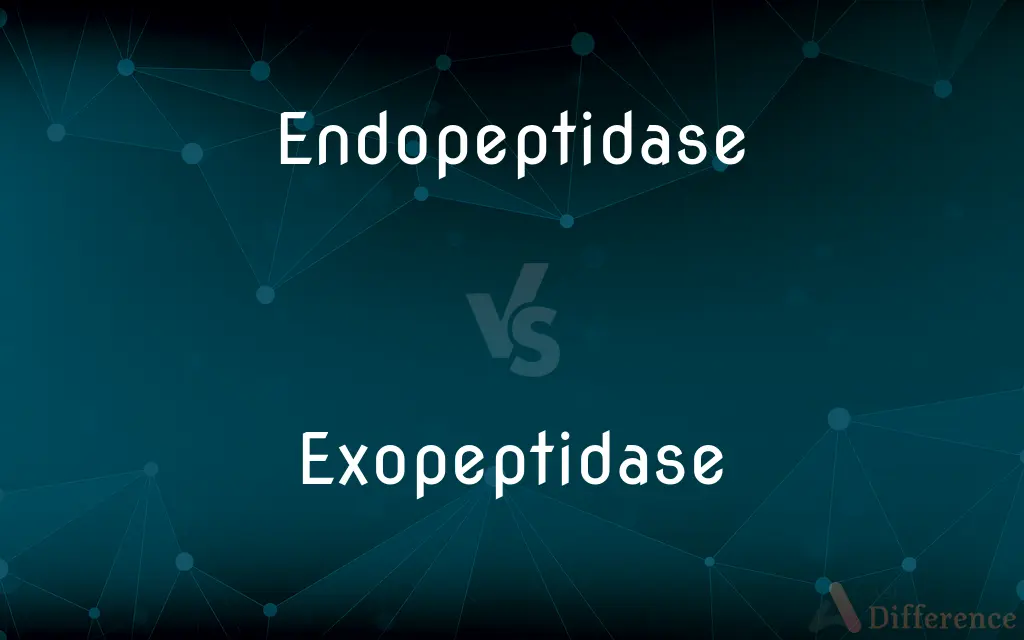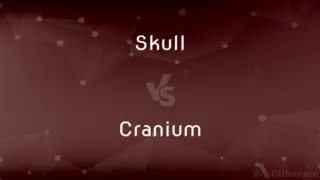Endopeptidase vs. Exopeptidase — What's the Difference?
Edited by Tayyaba Rehman — By Fiza Rafique — Updated on October 1, 2023
Endopeptidase cleaves peptide bonds within a protein, while Exopeptidase breaks peptide bonds at the end of protein chains.

Difference Between Endopeptidase and Exopeptidase
Table of Contents
ADVERTISEMENT
Key Differences
Endopeptidase and Exopeptidase are both enzymes that play pivotal roles in protein digestion. The primary function of Endopeptidase is to target and cleave peptide bonds located within the internal regions of protein molecules. This internal cleavage action ensures that larger proteins are broken down into smaller peptide fragments. On the other hand, Exopeptidase acts specifically on the terminal ends of these peptides, cleaving off amino acids one at a time from either the amino or carboxyl terminus.
In terms of their function in digestion, Endopeptidase starts the process by breaking down complex protein structures into simpler peptides. Once these proteins are rendered into smaller chains, Exopeptidase takes over to further simplify these chains into individual amino acids or very small peptides. This sequential action ensures that dietary proteins are effectively broken down for absorption and utilization.
While both enzymes facilitate protein digestion, it's essential to note that they don't act in isolation. The body secretes various forms of Endopeptidases and Exopeptidases, each having specificities for different peptide bonds or terminal amino acids. This means that multiple enzymes of each type may work together to ensure efficient protein digestion.
In essence, while both Endopeptidase and Exopeptidase share the goal of digesting proteins, their specific actions within this process are distinct. They operate in tandem, with Endopeptidase initiating the breakdown and Exopeptidase finalizing the process.
Comparison Chart
Action Site
Within a protein chain.
At the ends of a protein chain.
ADVERTISEMENT
Function
Breaks internal peptide bonds.
Cleaves terminal amino acids.
Resultant Fragments
Smaller peptide fragments.
Individual amino acids or very small peptides.
Specificity
Targets specific internal peptide bonds.
Acts on specific terminal amino acids.
Role in Digestion
Initiates protein breakdown.
Finalizes protein breakdown.
Compare with Definitions
Endopeptidase
Initiates protein digestion.
For efficient protein digestion, the action of Endopeptidase is crucial.
Exopeptidase
Enzyme breaking peptide bonds at protein ends.
Exopeptidase ensures proteins are fully digested by acting on terminal amino acids.
Endopeptidase
An enzyme that cleaves internal peptide bonds.
Endopeptidase facilitates the breakdown of dietary proteins into smaller peptides.
Exopeptidase
Finalizes protein digestion.
Following the action of Endopeptidase, Exopeptidase completes the protein breakdown.
Endopeptidase
Produces peptide fragments from proteins.
Upon action by Endopeptidase, long protein chains are fragmented.
Exopeptidase
Acts on specific terminal amino acids.
Different forms of Exopeptidases have specificity for distinct terminal amino acids.
Endopeptidase
Targets specific bonds within proteins.
Different types of Endopeptidases recognize and act on distinct peptide bonds.
Exopeptidase
Produces individual amino acids from peptides.
Exopeptidase action results in the release of single amino acids from peptide chains.
Endopeptidase
Essential for the first step in protein digestion.
Without Endopeptidase, the initial breakdown of dietary proteins would be hindered.
Exopeptidase
Essential for the last step in protein digestion.
Protein digestion is finalized by the specific actions of Exopeptidase.
Endopeptidase
Endopeptidase or endoproteinase are proteolytic peptidases that break peptide bonds of nonterminal amino acids (i.e. within the molecule), in contrast to exopeptidases, which break peptide bonds from end-pieces of terminal amino acids.
Exopeptidase
An exopeptidase is any peptidase that catalyzes the cleavage of the terminal (or the penultimate) peptide bond; the process releases a single amino acid or dipeptide from the peptide chain. Depending on whether the amino acid is released from the amino or the carboxy terminal, an exopeptidase is further classified as an aminopeptidase or a carboxypeptidase, respectively.
Endopeptidase
Any of a large group of enzymes that catalyze the hydrolysis of peptide bonds in the interior of a polypeptide chain or protein molecule.
Exopeptidase
Any of a group of enzymes that catalyze the hydrolysis of single amino acids from the end of a polypeptide chain.
Endopeptidase
(enzyme) Any of a group of enzymes, such as trypsin, chymotrypsin, pepsin and elastase, which catalyze the splitting of polypeptide chains away from the ends
Exopeptidase
(enzyme) Any of a group of enzymes which catalyze the removal of a single amino acid from the end of a polypeptide chain
Common Curiosities
Are there different types of Endopeptidases and Exopeptidases?
Yes, both have various forms with specificities for different peptide bonds or terminal amino acids.
Can Endopeptidase break down a protein into individual amino acids?
No, Endopeptidase breaks proteins into smaller peptides; Exopeptidase completes the process.
Is the action of Exopeptidase faster than Endopeptidase?
Not necessarily; their action depends on substrate availability and enzyme concentration.
Are these enzymes found in the stomach?
They're present in the digestive tract, with some in the stomach and others in the small intestine.
Can we find Endopeptidase and Exopeptidase in dietary supplements?
Yes, some digestive enzyme supplements contain these enzymes to aid protein digestion.
Why is the sequential action of both enzymes important?
They ensure that dietary proteins are broken down efficiently for absorption and use.
Is the action of Endopeptidase enough for protein digestion?
No, Endopeptidase initiates, but Exopeptidase is necessary to finalize digestion.
What's the primary difference between Endopeptidase and Exopeptidase?
Endopeptidase acts on internal peptide bonds, while Exopeptidase acts on terminal ends.
Can Exopeptidase act on a whole protein?
Typically, no. Exopeptidase acts after Endopeptidase has broken down the protein into peptides.
Can an imbalance of these enzymes affect health?
Yes, imbalances or deficiencies can impact protein digestion and absorption.
Are these enzymes produced naturally in the body?
Yes, they are naturally secreted in the digestive tract for protein breakdown.
Do both enzymes require similar conditions to function?
While both are involved in protein digestion, their optimal pH and conditions may differ.
Share Your Discovery

Previous Comparison
Skull vs. Cranium
Next Comparison
Blog vs. WebsiteAuthor Spotlight
Written by
Fiza RafiqueFiza Rafique is a skilled content writer at AskDifference.com, where she meticulously refines and enhances written pieces. Drawing from her vast editorial expertise, Fiza ensures clarity, accuracy, and precision in every article. Passionate about language, she continually seeks to elevate the quality of content for readers worldwide.
Edited by
Tayyaba RehmanTayyaba Rehman is a distinguished writer, currently serving as a primary contributor to askdifference.com. As a researcher in semantics and etymology, Tayyaba's passion for the complexity of languages and their distinctions has found a perfect home on the platform. Tayyaba delves into the intricacies of language, distinguishing between commonly confused words and phrases, thereby providing clarity for readers worldwide.
















































